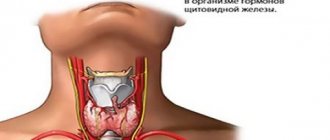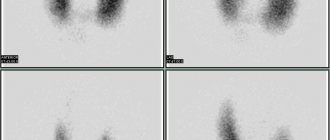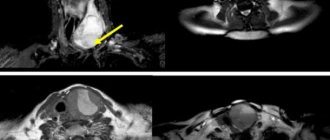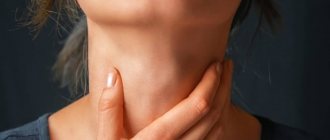Thyroid puncture is a procedure in which a needle is inserted into the gland to obtain a tissue sample for testing. This procedure is called a fine-needle aspiration biopsy. It is performed when a nodule is found in the thyroid gland, usually to determine whether it is cancerous.
Our expert in this field:
Allahverdyan Alexander Sergeevich
Surgeon-oncologist, professor, MD. Head of the ROH expert group. International expert
Call the doctor Reviews about the doctor
The thyroid gland is a small endocrine organ that is located under the skin on the front of the neck. It is shaped like the letter “H” or butterfly, and consists of two lobes connected by a narrow isthmus. The thyroid gland weighs only 12–25 g, its volume is up to 25 ml in men and up to 18 ml in women. It accumulates iodine and produces hormones that affect many processes in the body, participate in the regulation of metabolism, the growth of individual cells and the body as a whole.
Some people develop lumps called nodules in the thyroid gland. Most often, this is a benign growth of normal tissue, a cyst, a manifestation of chronic inflammation, multinodular goiter, endemic goiter associated with iodine deficiency. Less than 5% of all nodules found in the thyroid gland are malignant. In some cases, an accurate diagnosis can only be made after a biopsy.
Fine needle aspiration biopsy of the thyroid gland is a safe and informative diagnostic method that has many advantages:
- High diagnostic accuracy - 95%.
- Reliability: In most cases, it is possible to reliably judge whether a thyroid nodule is benign or malignant.
- To obtain a tissue sample, you do not need to make an incision or use general anesthesia.
- When using local anesthesia, the procedure is completely painless.
- Short recovery period.
In what cases is a thyroid puncture necessary?
Usually, nodules in the thyroid gland are identified by an endocrinologist during palpation (palpation), or they are detected during an ultrasound. Sometimes there are large nodes that are noticeable under the skin, deform the neck, and impair breathing and swallowing.
For some patients, it is enough to undergo an ultrasound examination, a computed tomography scan of the neck and a blood test for hormones. These diagnostic methods can show that the nodule is not cancerous. But in most cases, the diagnosis has to be clarified using puncture and fine-needle biopsy.
You can suspect the malignant nature of a node during an ultrasound based on some signs:
- low echogenicity (dark color in the images);
- heterogeneous structure;
- absence of a dark Halo rim around the node - it is usually detected with benign formations;
- uneven, unclear boundaries;
- irregular shape;
- the presence of compactions - calcifications;
- abundant or, on the contrary, poor blood supply;
- enlarged lymph nodes - this may indicate that they are also affected by a malignant tumor.
The risk that the nodule will be malignant is increased in people with a family history (thyroid cancer in close relatives), in those who previously suffered from cancer of the endocrine organs, or were exposed to ionizing radiation.
In accordance with modern recommendations, a diagnostic puncture is indicated when a node with a diameter of 1 cm or more is detected in the thyroid gland, which is determined by touch.
The doctor decides whether it is necessary to perform a puncture of the thyroid gland and a biopsy of the node, in each case individually, after studying the results of ultrasound and other studies. Some criteria play an important role:
| Factors that indicate a high risk of thyroid cancer | Factors that indicate a low risk of malignancy (puncture can be postponed) |
|
|
You can get advice from a competent specialist at the international clinic Medica24. Our doctors work in accordance with modern international standards.
We will call you back, leave your phone number
Message sent!
expect a call, we will contact you shortly
About the organ
The thyroid gland is a small organ (about 4 cm in height and weighing 20 grams), shaped like a butterfly with spread wings. However, it is he who bears enormous responsibility for the metabolism in our body, the cardiovascular and nervous systems, sexual activity and the psycho-emotional sphere.
The organ is located in the front of the neck, below the Adam's apple. The gland covers the trachea and, being a very soft organ, is not detected in a normal state. It can be palpated and clearly visible; it is at the stage of some pathology.
Medical statistics tell us: problems related to the thyroid gland occur more often in women than in men. This is partly explained by the fact that representatives of the fair sex are forced to spend a larger period of their lives in a cyclical mode, determined by the alternating activity of two sex hormones-antagonists - progesterone and estrogen.
Preparation for the procedure
Thyroid puncture does not require special preparation. There is no need to adjust your lifestyle, adhere to a special diet, etc. If the patient is constantly taking any medications, then they do not need to be discontinued, with the exception of anticoagulants. These drugs are used to “thin the blood” and prevent blood clots. Because of them, after a puncture of the thyroid gland, the risk of bleeding may increase. The doctor decides whether they should be canceled a few days before the procedure.
Typically, fine-needle aspiration biopsy is performed by endocrinologists. They are better at this than other specialists because they often have to palpate the thyroid gland. It is advisable that the puncture be carried out by a doctor who will subsequently care for the patient.
How can I come to you for a consultation and biopsy?
To make an appointment for a biopsy and consultation with an endocrinologist surgeon or endocrinologist at the North-Western Endocrinology Center, you need to call the Petrograd or Primorsky branches of the Endocrinology Center:
- (812) 498-10-30, from 7.30 to 20.00, seven days a week
,
St. Petersburg, Kronverksky pr., 31
(200 meters on foot to the left from the Gorkovskaya station, in the very center of the city, 500 meters from the Peter and Paul Fortress ). For those arriving by car, there is parking right in front of the entrance to the Center. - (812)565-11-12
, from 7.00 to 21.00 weekdays, from 7.00 to 19.00 - weekends, St. Petersburg, Savushkina street, 124, building 1 (250 meters to the right from the Begovaya metro station). There is adjacent car parking in front of the Center entrance.
How is the puncture performed?
Diagnostic puncture of the thyroid gland lasts on average 20 minutes. During the procedure, the patient is usually placed on his back and a pillow is placed under his shoulders to tilt his head back slightly. This makes it easier for the doctor to access the thyroid gland.
General anesthesia is not required during puncture. Some doctors use local anesthesia - they inject the intervention area with a lidocaine solution. This allows you to completely avoid pain. Anesthesia may not be required. In this case, the sensations during the puncture will be the same as during an injection into a vein.
For aspiration biopsy, a thin needle (22, 25 or 27 gauge) and a 10-20 ml syringe are used. For convenience, it can be inserted into a special metal holder.
Thyroid puncture is performed under ultrasound control. Ultrasound navigation helps to insert the needle exactly into the right place and not damage neighboring anatomical structures.
It is recommended to obtain tissue samples from at least 2 places - this reduces the risk of error. Often 3–6 attempts are made, and some experts recommend at least six.
If there is a cyst (a cavity with fluid) in the thyroid gland, a needle is inserted into it, the contents are aspirated, and then a biopsy of the remaining tissue is performed. The fluid from the cyst is collected in a separate container and sent for cytological examination.
Contraindications
There are no special contraindications that prohibit this manipulation. However, there are several limitations that a doctor should consider when ordering a biopsy. Among them:
- cardiovascular diseases,
- poor blood clotting,
- patient's age,
- undergone surgical interventions,
- heart problems,
- the size of the neoplasm is over 35 mm.
However, the doctor considers each case individually. If necessary, intravenous anesthesia can be used to perform a biopsy.
After the procedure
After the necessary tissue samples are obtained, the needle is removed and a tampon is applied to the puncture site, applying pressure. When the bleeding stops, a patch is applied. It can be removed after a few hours. The patient is asked to sit up slowly to avoid dizziness. His condition is observed for several minutes and then released to the ward or home.
Pain may occur at the puncture site for 1–2 days. They can be treated with painkillers and local cold.
Restrictions
There are certain contraindications in which trepanobiopsy is prohibited:
- pathologies associated with blood clotting disorders;
- severe diseases of the respiratory system, cardiovascular system, kidneys, liver;
- skin diseases, as well as various inflammations or pathologies of subcutaneous fat at the puncture site;
- the patient’s inability to accept the position required for the procedure (this may be caused by a disruption in the functioning of the hip and knee joints - manifested as pain in the hip and knee);
- joint pathologies;
- if the patient is allergic to anesthesia.
Possible complications
Thyroid puncture is rarely accompanied by complications. Ultrasound-assisted navigation makes this procedure even safer. Cases of spread of a malignant tumor due to needle insertion, damage to neighboring organs, nerves, and blood vessels are practically never encountered.
Most often, after a fine-needle biopsy, pain occurs and the color of the skin at the injection site changes slightly. But even small hemorrhages on the skin are rare. Isolated cases have been described in which bleeding developed into the cyst, and because of this it had to be removed.
If the rules of asepsis and antisepsis are followed, the risk of infection is also extremely unlikely.
We will call you back, leave your phone number
Message sent!
expect a call, we will contact you shortly
Types of biopsy
To take biological material from thyroid nodules, two standard methods are used:
- Open biopsy. This method of collecting material involves making a special incision through which biological material is taken. This method is quite traumatic, so it is used only if there are special indications.
- A fine-needle biopsy is performed using a thin needle under the supervision of ultrasound machines. This research method is the most accurate.
high-quality biopsy of thyroid nodules is one of the most important stages of the examination. Among the main advantages of this procedure are the following:
- provides reliable information,
- does not cause difficulties in execution,
- well tolerated by patients
- it does not require special expensive devices.
Are errors possible?
Aspiration biopsy of the thyroid gland is a fairly accurate diagnostic method. However, in rare cases errors may occur:
- A false positive result is when there is no malignant tumor, but laboratory specialists thought that there was one. The probability of such an error is 3%.
- False negative results occur in less than 5% of cases. However, tumor cells are not detected in the laboratory, but in fact the patient has a malignant tumor.
The reasons for errors can be different: the inexperience of the doctor who performed the puncture, the laboratory employee, the peculiarities of the histological structure of various neoplasms. Nodules less than 1 cm in diameter may be difficult to penetrate with a needle, and nodules larger than 4 cm may not be able to collect tissue samples from all parts of the nodule.
If your attending physician has doubts about the diagnosis, get a second medical opinion from specialists at the international clinic Medica24.
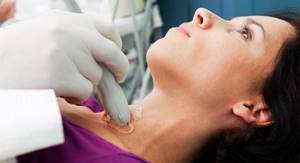
Cancer withdrawn into itself
Our traditional understanding of thyroid cancer, namely its development, has fundamentally changed thanks to three studies in 2014 (Thyroid cancer trilogy) [3–5]. It would seem that all malignant tumors undergo progression as they develop, and therefore require early diagnosis and surgical treatment. For the first time in human history, the existence of “self-limiting cancers” was discovered, which are malignant, but do not progress to lethal forms due to the limited ability to divide the cells that make up the tumor. Of course, there are also so-called lethal thyroid cancers. The difference between them lies in the origin of the cancer cells, which determines the development of the disease and its outcome. In the second case, the cells seem to be hidden for a long time, for years and even decades, and then, for still unclear reasons, they suddenly begin to divide and lead to an unfavorable outcome. However, at the moment it is believed that it is the “self-limiting” types of thyroid cancer that make up the majority.


